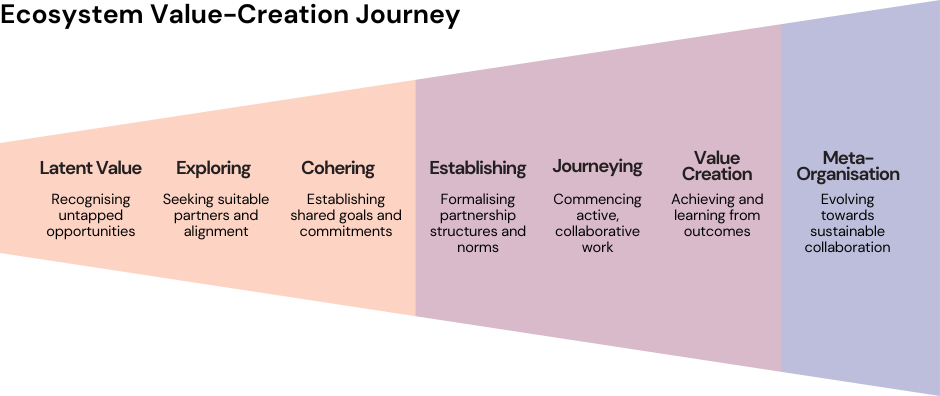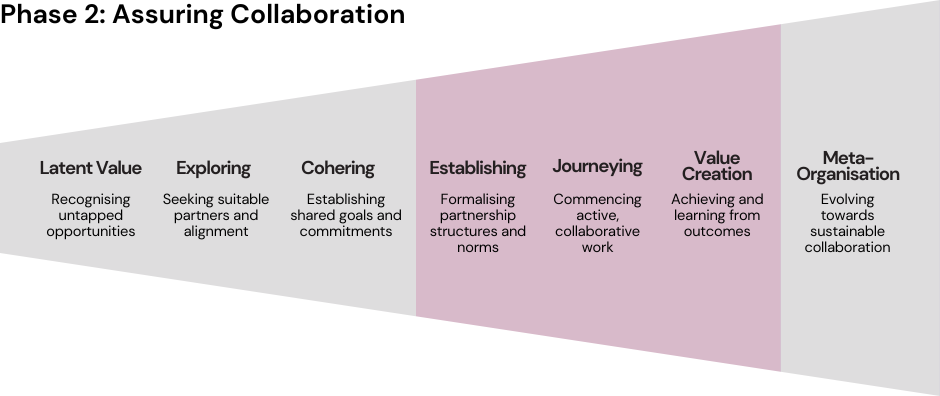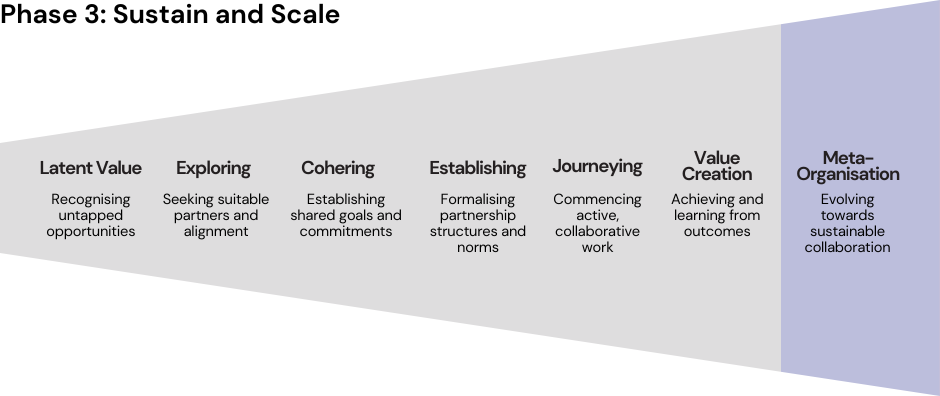So many of the big global challenges we face require collaboration at a massive scale, if we have any chance to succeed. Whether it’s nimble, multi-organisational consortia, or large system-spanning coalitions, collaboration is easier said than done. So what can be done to help these collaborations to thrive?
In this article, I’m sharing a framework I’ve been using for the past year that helps to make sense of the collaborative journey of consortia and coalitions. So far, I’m describing it as an ‘Ecosystem Value-Creation Journey’. Hopefully, it proves useful to others, and at the very least provokes some useful discussion. Let’s get on with it shall we?
This is the basic journey pattern. I’ll provide some context, and then some description of what’s happening at each stage:

Ecosystem Value-Creation Journey: a common journey experienced by consortia and coalitions to bring value to life in an ecosystem
Where did it come from?
This ecosystem value-creation journey has been derived from a diverse set of experiences (my own, and those of my colleagues at ThinkPlace). Examples of these experiences include:
- Private-sector partnerships between multiple businesses and technology partners, to stand up complex digitally enabled transformations (e.g. supply chain digitalisation)
- Public sector initiatives to codesign government policy, strategy and regulation and programs with citizens and stakeholders
- Donor-driven efforts to bring together ‘dream team’ consortia to tackle complex issues in the developing world
- Alliance building initiatives that build organically out of necessity within or across sectors.
These examples all have one thing in common: they represent efforts to bring together the capability, perspectives, information and power that sits in separate organisational boundaries, to achieve what they cannot alone.
When and why is it useful?
Specifically, it’s a helpful explanator or guide for navigating the messy business of consortia and coalition building. It helps to contextualise the challenges that collaborative endeavours often face, and how to improve chances of success along the way (so at the very least you can take comfort in having greater insight into why you are going mad).
Note that it isn’t intended to be a universal model of ecosystem collaboration. It’s specifically about the use of consortia and coalitions as a means of driving change within ecosystems. I use these terms very loosely:
- Consortia refer to smaller, nimbler teams of people or organisations that come together to do something (like starting up a new business, or designing a new regulatory scheme). They’re usually racing to get something done with the shared, diverse capabilities they can bring together. They are more likely to be a ‘disruptor’.
- Coalitions refer to larger assemblies that seek to bring together a fairly representative, influential sample of an overall ecosystem. They’re usually good for collective sensemaking and seeking to form and align intent and direction for larger-scale change. They’re usually less good at taking concrete action (at least quickly).
In projects like ARENA’s A-Lab, Coalitions and Consortia go hand-in-hand — the coalition, which is seeking to drive whole-of-sector change (in this case, renewable energy transition), helps to set direction, and spawns consortia that take action.
Walking through the stages of the journey
Whether working at the consortia or coalition scale, there tend to be a few key stages that these arrangements need to step through. While it’s nice and neat as a diagram, bear in mind that may not be so linear.
At its most basic level, this journey describes how latent opportunities in an ecosystem can be realised — particularly in the absence of a forceful convening power (like a government agency). In subsequent articles, I’m going to get into more detail on each stage, what’s usually involved, where things go wrong, and what can help. For now, however, I’ll just give the basic explanation of each stage.

Latent Value
The journey typically begins with someone, somewhere, glimpsing an opportunity, but they know they can’t achieve it by themselves. For example a new technology creates a new opportunity, or someone makes some serendipitous connections between some factors that were already there.
It can also start with a shared sense that the status quo is untenable, and there’s energy to come together and find a better way (we see this a lot now around high profiles spaces like sectoral decarbonisation).
Often, the people around the first glimpser (I’ll call them the champion) don’t see what they see. Or they just see the risk involved. For the champion, they themselves may be looking for validation of the risk and return from the idea. If they are willing to turn outwards for that information, they start to explore.
Exploring
For our champion, that initial glimpse kicks off an exploration, to find the partners with the right perspectives, capabilities and values (and the willingness to spend some time to understand) who can help make the ‘glimpse’ into a real concept. This search, and the due diligence that goes with it, can be expensive. Access to networks helps to bring down the cost to find the right partners, particularly where that can confer trust (and it’s here that things like Singapore’s open innovation platform, or Greenhouse’s Challenge Platform can be useful). It also requires balancing the ‘right’ capability with the right chemistry. Who can work well together? What’s the optimal set of partners to bring the capability needed?
Cohering
The most critical point in the journey is the one I’ve labelled as ‘coherence’. This is the point where partners need to clarify a more concrete intent together, along with identifying individual payoffs. This matters, because from this point, they need to more formally commit resources (and maintain accountability for it). The clock is ticking for the partners to find this coherent intent, and make commensurate commitments, otherwise they’ll swiftly start to drift apart.
It’s worth noting that there’s no right answer as to how coherent and considered the intent has to be. It just needs to be enough to give partners confidence to proceed, and the definition of ‘enough’ will depend on the risk appetite of the partners.
I’ve found it helpful to identify ‘reasons to believe’ and ‘reasons to disbelieve’ in the hypothesis being created. This can then be useful to track over time. If the reasons to believe start to strengthen and the reasons to disbelieve start to fall away, you have confidence to continue. If the opposite is true, you have a basis for a graceful exit.
Assuming partners can find that coherent intent, however, then this where a phase shift occurs, and the emerging partnership moves from something ad hoc, to something more formal.

Establishing
At this point, the emerging partnership needs to find the right form to match their intent and context. This can be anything from establishing a joint project, to a legal consortia, to a collective. Each partner will be coming with their own cultural norms, ways of working, tools and systems. Getting the form and systems right is important because it continues the process of trust building. While it’s not always possible to get it all right up front, it’s still worth taking the time to (co)design the arrangements, to create the conditions for trust (shared principles, expectations, processes and governance). These arrangements will often then evolve through experience.
Journeying
This is the bit where the partners formally ‘kick off’ and start active collaboration together. Journeying can look very different across different consortia and coalitions, depending on how they’ve established and what they are doing, with just as many methods for helping to manage and facilitate collaborative working.
A lot of what happens here is really the classic challenges of getting diverse people to work together. Obviously, a lot has been written about this, but usually in the context of getting people to work together within an organisation. In the context of consortia and coalitions, we’re forming a meta-organisation, made up of people from many different organisations, each of whom brings their own norms, language and expectations.
Tuckman’s team model of ‘forming, storming, norming and performing’ has been around since the 60s, and is still useful for describing the experience of collaborative teaming. Many collaborative initiatives stay stuck in storming, with contests over preferred methods and key decisions. The challenge with collaborative partnerships like consortia and coalitions is just as much the people challenge, as it is the technical challenge of what they are doing. Sometimes more so. Things that easily go wrong include:
- Lack of genuine commitment to the shared initiative means people stay stuck in their day job.
- Self-interest starts to predominate, and partners jockey for power and budget — sometimes because they genuinely think they can do it best, and therefore believe they are acting in the interests of the project, and sometimes simply because they are acting in bad faith.
- The urgency and pressure of the initiative doesn’t allow for the time needed to connect and build relationships for effective working, so trust isn’t built and things stay transactional and shallow, and declining confidence over time.
This list could go on, and I’d love to hear your own (perhaps over a whisky).
Value Creation
I’ve gone back and forth over what to call this part (results, achieving, learning, realisation?). The reason is that there are a lot of pathways and end-points that can happen here. Examples include:
- Things were reasonably straightforward, we achieved our intent, much as we expected to, and we’re happy
- Things didn’t work out, and we couldn’t achieve what we wanted (but in reality, we’ve probably learnt and grown), hopefully with an early and graceful exit (I’m enjoying reading about stewarding loss and organisational composting approaches at the moment by the way)
- Things evolved and changed, possibly including our intent, so through working together we explored our way to something else valuable
The value created through these collaborative initiatives should be viewed broadly. Often the core focus of the initiative acts more as a trojan horse, around which the partnership can assemble. The pace of learning for all involved is usually high, given the creative abrasion of diverse people. Sometimes the real value is what comes after (even years after), as a result of relationships built.

Meta-Organisation
The last stage of the journey is really a recognition that collaboration is often cyclical, and can create its own flywheel over time as trust deepens. Sometimes an initial foray becomes a quick win, paving the way for something more ambitious. A lot of the partnership models (like the Partnership Brokers Association’s Partnering Cycle) are cyclical for this reason.
Consortia and coalitions are often a prelude to more permanent structures that absorb the different capabilities of the partners. They can become long term alliances, or industry associations. They can become joint ventures and traditional companies. They can also shift into permanent community or collective arrangements.
Taken to the extreme, the consortia/coalition journey can be thought of as a kind of ‘organisational reproduction’ with the sharing of organisational DNA — but perhaps don’t say that on the first date.
A few last observations
I’m currently using this framework as the basis for three very different consortia or coalition projects (on the energy transition, controlling digital scams, and regenerative forestry). There are a few, interconnected things that keep getting reinforced in these live projects:
- Trust is the key material: a thorough and considered approach to trust building at every stage of the journey matters. We need to be creating a high trust environment within which these collaborations form.
- Informal networks will win every time: if you can bypass the institutions and official channels, and fall back on humans and their little black books, things go a hell of a lot faster.
- Snowballs are your friend: to channel open space technology, ‘whoever turns up are the right people’. In the context of consortia and coalition building, it’s better to start with the people you know, and build from there. As the centre of gravity builds, more people are drawn in.
There’s plenty more to share and discuss around what’s happening in this journey. If there’s interest, I can do a deeper dive into the various stages, the challenges within them, and what can be done about them. At the end of the day, this framework is just a way to think and guide action in order to assure collaboration of this sort. There are enough urgent, global transitions that require these collaborative forms that necessitate us getting it right.
This article also builds on an earlier one I wrote on an emerging zeitgeist around ecosystem collaboration, that sees relationships (and trust) as the foundation for everything else. That thinking also marks a departure from designing directly, to designing for the conditions of emergence in preferred directions.
If you like to nerd out about this stuff (or if you’re in the midst of it and need to vent) please connect with me on LinkedIn and say hi!

